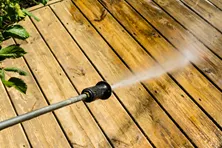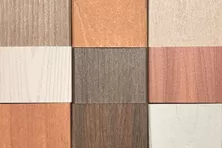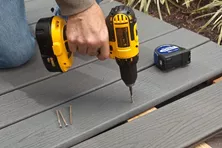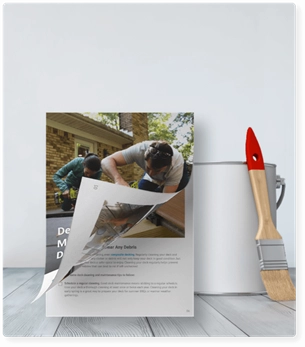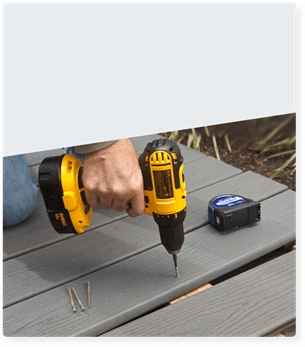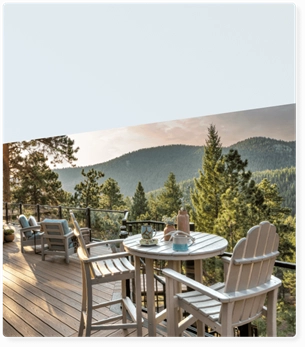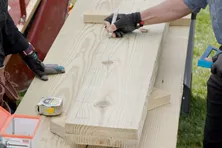How to Prepare & Protect Your Deck for Winter
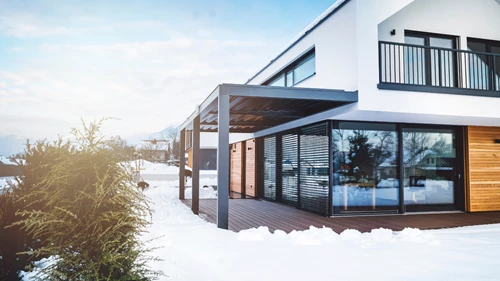
Winter is coming. Is your deck ready?
With the arrival of cooler weather in the fall, many homeowners begin preparing their landscaping for the cold winter months – planting bulbs, mulching, trimming and general yard maintenance. Your deck should be on the list, too.
Cold weather deck preparation is equally important, especially if it’s made of natural wood or you’re in an area where winters are particularly harsh. It will prolong your deck’s lifespan and save you time, effort and money in the long run. It’ll also give you a head start on enjoying your deck in the spring and summer.
Steps to Protect & Prepare Your Deck for Winter
Now that we’ve established the importance of preparing and protecting your deck for winter, what does it entail, exactly? Let’s find out.
Remove Dirt, Leaves And Debris
It may not seem like a big deal, but over time, dirt, leaves, pine needles and other debris can build up on your deck and in between floor boards. In winter, this debris gives snow and ice a better opportunity to build up and lock in moisture, and moisture is not a good thing for your deck; it causes wood rot and other structural and integral damages. Make sure your deck is free of debris before winter sets in.
Clean Your Deck and Get Rid of Mildew
It’s a good idea to clean mildew from your deck before winter. If left untreated, a thick accumulation of mildew can become slippery when wet.
You can buy a commercial product to combat mildew or create your own simple solution from common household cleaners. One homemade formula calls for three quarts of hot water, six dry-measure ounces of powdered certified organic oxygen bleach, and ¼ cup of ammonia-free liquid dish detergent. Stir the powdered oxygen bleach until it dissolves.
Apply a generous amount of the solution to your deck’s surface with a hand-pump garden sprayer and let sit for 10-15 minutes before lightly scrubbing. A stiff scrub brush on a painter’s pole works well. Rinse well immediately after scrubbing. Don’t be tempted to use chlorine bleach, or any product containing sodium hypochlorite. Chlorine bleach is toxic to all nearby vegetation and trees. It can accelerate the corrosion of the deck fasteners and any metal structural connectors.
Inspect Your Deck
Before putting your deck on winter hiatus, it’s recommended that you perform a general inspection. Inspect the top surface as well as underneath to spot areas where moisture may have hidden and created weak spots. Use an old-fashioned ice pick or a very thin flat-headed screwdriver and probe any wet areas of the wood. If rotted, the pick or screwdriver will penetrate the wood with ease.
You should also look for any loose railings or footings and tighten up any hardware that could compromise your deck over the winter months.
Seal & Finish Your Deck
Of all the ways to properly protect and prepare your deck for winter, there’s one you should never fail to overlook –sealing and finishing. Sealing or staining your deck is one of those upkeep items that should be done at least every 2-3 years to protect your deck’s lumber from rain, snow and ice.
An unsealed deck is subject to moisture penetration, which can cause warping, cracking, splintering and - more than likely - rot. And as we know, deck rot is not something you want. Deck rot can destroy the integrity and strength of your deck along with increasing the chances for pest infiltration.
If you decide to seal, be sure to follow the cleaning instructions above using certified organic oxygen bleach. Follow the label instructions on the sealer and pay close attention to any guidelines about low-temperature application.
Removing Snow & Ice from Your Deck Surface
Now that you’ve learned about preparing your deck for winter, what do you do during the actual cold season? Protecting a deck in winter is different than prepping it for winter. Is snow bad for a deck? Can you salt your deck? How do you shovel a deck? There are a lot of winter-specific questions that surround deck care.
How to Remove Snow From Your Deck
For a light dusting of snow, you can use a simple broom in lieu of a snow shovel. If using a shovel, exercise caution, as certain materials can scuff or scratch your deck.
However, if you live in a region that gets a decent amount of snowfall and you need to use a shovel, it’s important that you shovel along the length of the deck boards (with the grain). Never run the shovel across the width of the boards; doing so may scratch the deck and ruin stain or paint. Additionally, don’t use a metal shovel. While they are more durable than their plastic counterparts, they are much harder on your deck and can result in scratches, dings and dents.
Use Caution When Salting Your Deck
One of your first thoughts when preparing for winter may be to salt your driveway, sidewalk and deck, but when it comes to your deck, whether you should use rock salt depends on the material.
Calcium chloride or rock salt can be used to melt snow and ice from the surface of most composite decks. If you own an older composite deck, calcium chloride or rock salt may be used but should be rinsed off as soon as possible. However, with wood decks, you might want to skip salting your deck. Salt and ice melt can harm some deck finishes, which means in the spring, you’ll be re-staining to fix any discoloration.
More Things to Consider Before Winter
With frigid winds, sheets of ice, and grimy, hard-to-melt mountains of snow, the winter months can be tough on a deck, so there are some additional considerations to keep in mind.
Cover Your Deck with a Tarp for Winter
For some homeowners, the easiest solution may be to simply place a tarp over your deck and deck furniture – this will only work if you don’t plan to use your deck over the winter. Obviously, this is not a viable option for those who may have a hot tub, grill or outdoor fireplace on their decks that are used during winter.
If tarping your deck isn’t an option, you should at least consider tarping the furniture when not in use. Better yet, if you have room in a shed or garage, consider moving furniture to a protected and enclosed location.
Wind is a major issue when using tarps. The tarp must be secured well to prevent wind from blowing it away. The other issue with tarps is they can trap moisture. Remove the tarp as soon as the threat of snow and ice has diminished.
Explore Composite Decking to Reduce Upkeep
Composite decking is more resilient than wood, and is ideally suited for winter weather. It’s more durable and requires less maintenance than wood decking without sacrificing aesthetics or quality, so you can spend more time enjoying your outdoor space. Even if you choose not to use your deck during the winter months, your composite deck will be ready for you to enjoy when the warm weather returns.
Get Your Deck Ready for Warmer Weather
If spring rolls around and you notice areas that have warped or cracked due to moisture accumulation from snow or ice, contact a local builder through our Find a Deck Builder page. A professional will come inspect the damage and give you a quote for repair so that you can get back to enjoying the great outdoors from the comforts of your deck.
How to Pressure Wash a Deck
Pressure washing your deck is the best way to keep your investment looking like new. Learn how to properly clean your wood deck with these tips from Decks.com.
Deck Inspection: Checklist for Framing, Footings and More
Concerned that your deck no longer meets safety regulations? Want to know how to spot signs of trouble for your deck? Review our checklist for inspecting your deck at Decks.com.
Capped Composite Decking
What is capped composite decking? It's a great option if you like the look of wood but not the maintenance. Learn about capped composite at Decks.com.
Deck Screws vs Wood Screws
Your guide to understanding the differences between wood deck screws and composite deck screws.
Aluminum vs Composite Decking
Both Aluminum and Composite are great alternatives for traditional wood decking. Learn which material will best suit your home with our full comparison.
More Helpful Resources
Explore Articles by Topic

Footings
Information related to installing frost footings for decks

Framing
Learn structural framing methods

Decking
Learn about wood and composite decking materials

Stairs
An in-depth look at the complex issue of how to build stairs

Railings
How to install guardrails and handrails to meet IRC code

Features
An overview on water drainage, benches, planters and lights

Design
The basics of deck design

Planning
Learn about permits and working with contractors

Porches & Patios
Build a covered deck to enjoy all seasons

Ledger
Proper attachment techniques

Care
Maintain your deck to maintain your investment

Materials
An overview on water drainage, benches, planters and lights
How to Remove Scuffs and Scratches from Composite Decking
Removing scuffs and scratches can help make your composite deck look like new. Learn how to fix and prevent your composite deck from future scratches.
Deck Replacement & Repair Costs
Whether you’ve decided to tear down and rebuild your deck or if you’re only looking to repair smaller portions, you can find benchmark prices here.
Deck Maintenance Checklist
Wondering how to best care for your deck? Download our comprehensive deck maintenance checklist to ensure your deck is safe and lasts for years at Decks.com.
Is Trex Decking Worth the Investment? Expert Insights and Reviews
Discover why Trex decking is worth the investment. Learn about its durability, low maintenance, eco-friendliness, and the long-term value it adds to your home.
Gorilla Deck
Gorilla Deck Vinyl Decking is manufactured by Homeland Vinyl Products in Birmingham, AL.
Evergrain
Evergrain composite decking is manufactured by Epoch Composite Products in Lamar, MO.
Explore Articles by Topic

Footings
Information related to installing frost footings for decks

Framing
Learn structural framing methods

Decking
Learn about wood and composite decking materials

Stairs
An in-depth look at the complex issue of how to build stairs

Railings
How to install guardrails and handrails to meet IRC code

Features
An overview on water drainage, benches, planters and lights

Design
The basics of deck design

Planning
Learn about permits and working with contractors

Porches & Patios
Build a covered deck to enjoy all seasons

Ledger
Proper attachment techniques

Care
Maintain your deck to maintain your investment

Materials
An overview on water drainage, benches, planters and lights





